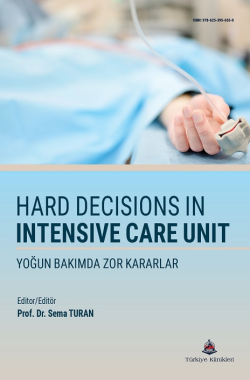RESPIRATUARY MONITORING
Saniye Cengiz
Gölhisar State Hospital, Department of Anesthesiology and Renimation, Burdur, Türkiye
Cengiz S. Respiratuary Monitoring. In: Turan S, editor. Hard Decisions in Intensive Care Unit. 1st ed. Ankara: Türkiye Klinikleri; 2025. p.395-402.
ABSTRACT
Respiratory failure is one of the leading causes of intensive care unit hospitalization. The purpose of respiratory monitoring is to monitor changes in the patient, to recognize them early and to determine the degree of severity; to evaluate the response to treatment and to prevent mortality and morbidity. For this, it is important to interpret the monitoring methods correctly, to be specific in the measured parameters, and to understand their current limitations well. In addition to methods such as arterial blood gas analysis and oxygen saturation monitoring, which have been used for a long time, there are monitoring methods such as lung ultrasonography and transcutaneous carbon dioxide monitoring, which have become widespread in recent years. In this article, respiratory system monitoring methods used in intensive care will be examined.
Keywords: Monitoring; Respiratuary; Internal care unit; Oxygenation; Mechanical ventilation; Lung ultrasonography
Kaynak Göster
Referanslar
- Özcan DN. Monitorizasyon. 2. ed. Özel Konular, ed. D.Y. Neslihan Alkış, Zekeriyya Alanoğlu. 2016.
- Ortiz-Prado E, et al. Partial pressure of oxygen in the human body: a general review. American journal of blood research. 2019.9(1):1. [PMC]
- Singer M, et al. Dangers of hyperoxia. Critical Care, 2021.25:1-15. [Crossref] [PubMed] [PMC]
- Hafen BB. and S. Sharma, Oxygen Saturation. 2023: StatPearls Publishing, Treasure Island (FL). [Link]
- Mengi T, et al. Pulse Oksimetre ve Transkutanöz Karbondioksit Monitorizasyonu. Yıldırım F, Kıraklı C, eds. Yoğun Bakimda Solunum Monitorizasyonu. Türkiye Solunum Araştırmaları Derneği. 2023:13. [Link]
- Quaresima V, Ferrari M, Scholkmann F. Ninety years of pulse oximetry: history, current status, and outlook. J Biomed Opt. 2024 Jun;29(Suppl 3):S33307. [Crossref] [PubMed] [PMC]
- Röttgering JG, et al. Determining a target SpO2 to maintain PaO2 within a physiological range. PLoS One, 2021. 16(5):e0250740. [Crossref] [PubMed] [PMC]
- Theerawit P, et al. Respiratory monitoring in adult intensive care unit. Expert review of respiratory medicine. 2017.11(6):453-468. [Crossref] [PubMed]
- Al-Halawani R, et al. A review of the effect of skin pigmentation on pulse oximeter accuracy. Physiological Measurement. 2023;44(5):05TR01. [Crossref] [PubMed] [PMC]
- Mari A, et al. Transcutaneous PCO2 monitoring in critically ill patients: update and perspectives. Journal of thoracic disease. 2019;11(Suppl 11):S1558. [Crossref] [PubMed] [PMC]
- Chatterjee M et al. A rate-based transcutaneous CO2 sensor for noninvasive respiration monitoring. Physiological measurement. 2015;36(5):883. [Crossref] [PubMed] [PMC]
- Edwards ZP. Annamaraju, Physiology, lung compliance. 2020. [Link]
- Hess DR, Respiratory mechanics in mechanically ventilated patients. Respiratory care, 2014. 59(11): p. 1773-1794. [Crossref] [PubMed]
- Brochard L. What is a pressure-volume curve? Critical Care. 2006;10:1-3. [PMC]
- Lu Q, Rouby JJ. Measurement of pressure-volume curves in patients on mechanical ventilation: methods and significance. Crit Care. 2000;4(2):91-100. [Crossref] [PubMed] [PMC]
- Mojoli FM, Pozzi E, Arisi. Setting positive end-expiratory pressure: using the pressure-volume curve. Current Opinion in Critical Care. 2024;30(1):35-42. [Crossref] [PubMed]
- Lutfi MF, The physiological basis and clinical significance of lung volume measurements. Multidisciplinary respiratory medicine. 2017;12:1-12. [Crossref] [PubMed] [PMC]
- Goligher EC, et al. Lung-and diaphragm-protective ventilation. American journal of respiratory and critical care medicine. 2020;202(7):950-961. [Crossref] [PubMed] [PMC]
- Schepens T, S Fard EC. Goligher, Assessing diaphragmatic function. Respiratory care. 2020.;65(6)807-819. [Crossref] [PubMed]
- Bertoni MS, Spadaro EC, Goligher, Monitoring patient respiratory effort during mechanical ventilation: lung and diaphragm-protective ventilation. Annual update in intensive care and emergency medicine 2020. 2020:21-35. [Crossref]
- Dres MA. Demoule, Monitoring diaphragm function in the ICU. Current Opinion in Critical Care. 2020;26(1):18-25. [Crossref] [PubMed]
- Heunks LM, Doorduin J, Van Der Hoeven JG, Monitoring and preventing diaphragm injury. Current opinion in critical care. 2015;21(1):34-41. [Crossref] [PubMed] [PMC]
- Kacmarek RM, Berra L, Villar J. On the road to surface monitoring of diaphragmatic activity in mechanically ventilated patients. Respiratory Care. 2018;68(11):1457-1458. [Crossref] [PubMed]
- Muttini S, et al. Relation between peak and integral of the diaphragm electromyographic activity at different levels of support during weaning from mechanical ventilation: a physiologic study. Journal of critical care. 2015;30(1):7-12. [Crossref] [PubMed]
- Jonkman A, et al. Analysis and applications of respiratory surface EMG: report of a round table meeting. Critical Care, 2024;28(1):2. [Crossref] [PubMed] [PMC]
- Bellani G, et al. Measurement of diaphragmatic electrical activity by surface electromyography in intubated subjects and its relationship with inspiratory effort. Respiratory care, 2018;63(11):1341-1349. [Crossref] [PubMed]
- buNurah HY, Russell DW, Lowman JD. The validity of surface EMG of extra-diaphragmatic muscles in assessing respiratory responses during mechanical ventilation: A systematic review. Pulmonology. 2020 Nov-Dec;26(6):378-385. [Crossref] [PubMed] [PMC]
- Kameda T, et al. Guidance for clinical practice using emergency and point-of-care ultrasonography. Acute Medicine & Surgery. 2024;11(1): e974. [Crossref] [PubMed] [PMC]
- Demi L, et al. New international guidelines and consensus on the use of lung ultrasound. Journal of Ultrasound in Medicine. 202342(2):309-344. [Crossref] [PubMed] [PMC]
- Buda N, et al. Recommendations for lung ultrasound in internal medicine. Diagnostics. 2020;10(8):597. [Crossref] [PubMed] [PMC]
- Blazic I, et al. The use of lung ultrasound in COVID-19. ERJ Open Research. 2023;9(1). [Crossref] [PubMed] [PMC]
- Vetrugno L, Biasucci DG, Deana C, Spadaro S, Lombardi FA, et al. Lung ultrasound and supine chest X-ray use in modern adult intensive care: mapping 30 years of advancement (1993-2023). Ultrasound J. 2024 Feb 12;16(1):7. [Crossref] [PubMed] [PMC]
- Brown BH. Electrical impedance tomography (EIT): a review. J Med Eng Technol. 2003;27(3):97-108. [Crossref] [PubMed]
- Nishimura M. Electrical Impedance Tomography: The Promise of Noninvasive Lung Images at the Bedside. Respir Care. 2020;65(3):402-403. [Crossref] [PubMed]
- Bachmann MC, et al. Electrical impedance tomography in acute respiratory distress syndrome. Critical Care. 2018;22:1-11. [Crossref] [PubMed] [PMC]
- Sella N, et al. Electrical impedance tomography: a compass for the safe route to optimal PEEP. Respiratory medicine. 2021;187:106555. [Crossref] [PubMed]
- Wrigge H, Muders T, Petroff D. Electrical Impedance Tomography: The Electrocardiogram for the Lungs? American Thoracic Society. 2023;208(1):3-5. [Crossref] [PubMed] [PMC]

